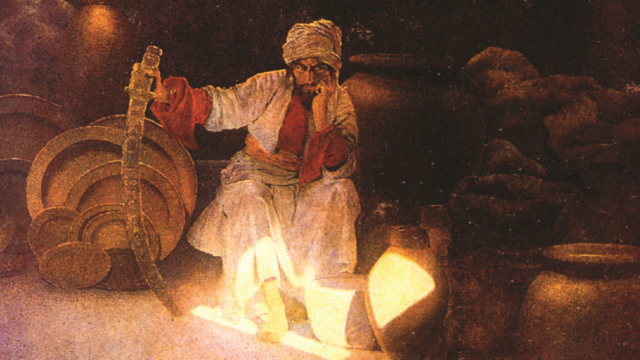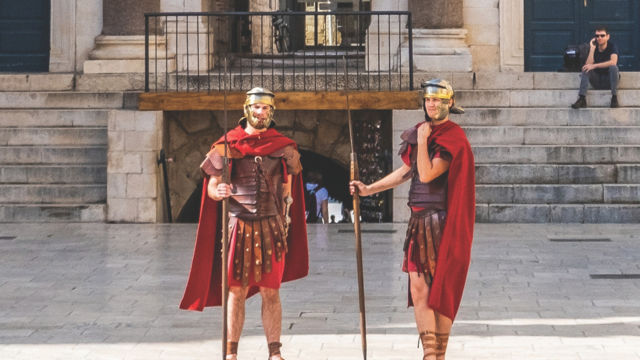-
QUALIFICATIONS
- For Linguists Worldwide
- For UK Public Services
- Preparation
- Policies & Regulation
-
MEMBERSHIP
- Join CIOL
- Professional Membership
- Affiliate Membership
- Chartered Linguist
- Already a member?
- Professional conduct
- Business & Corporate Partners
-
LANGUAGE ASSESSMENTS
- English
- All Other Languages
-
CPD & EVENTS
- Webinars & Events
- CIOL Conferences
- Networks
- CIOL Mentoring
-
NEWS & VOICES
- News & Voices
- CIOL eNews
- CIOL Awards
- The Linguist Magazine
- Jobs & Ads
-
RESOURCES
- For Translators & Interpreters
- For Universities & Students
- Standards & Norms
- CIOL & AI
- All Party Parliamentary Group
- In the UK
- UK Public Services
- Find-a-Linguist
Asterix reborn
Adriana Hunter on the challenges of translating the most recent book in the pun-laden series, and the pressures of following in the footsteps of its much-loved translator Anthea Bell
 In January 2017, Adriana Hunter was approached “very discreetly” by Hachette Children’s Books about the possibility of translating the next Asterix book. Anthea Bell, who had worked on the previous 37 books (with Derek Hockridge until his death in 2013), had retired due to ill health. Following in the footsteps of such a renowned translator, negotiating the many pitfalls of the pun-laden text and doing justice to a French classic with dedicated fans across the world was a daunting prospect, despite Hunter’s many years of experience.
In January 2017, Adriana Hunter was approached “very discreetly” by Hachette Children’s Books about the possibility of translating the next Asterix book. Anthea Bell, who had worked on the previous 37 books (with Derek Hockridge until his death in 2013), had retired due to ill health. Following in the footsteps of such a renowned translator, negotiating the many pitfalls of the pun-laden text and doing justice to a French classic with dedicated fans across the world was a daunting prospect, despite Hunter’s many years of experience.
Although she had more than 60 novels under her belt, and a number of accolades, including the 2013 French-American Foundation’s Annual Translation Prize, this was set to be a job like no other – with a complicated editing process, a rigid six-week schedule and “industrial espionage” level security. She sent off a test translation with an outline of relevant work, and waited to see if she would get the call.
Hunter had learnt French as a child when her family spent four years in Switzerland (where she became familiar with Asterix in French), and studied French and Drama at university. Starting out in film publicity and copywriting, she fell into translation “by accident” after being so “blown away” by Geneviève Jurgensen’s La Disparition that she made a sample translation, which was picked up by Flamingo Books in 1999.
Although she had met Bell on several occasions – and had even looked at an English-language version of Asterix just to see the translator’s talent at work – they had never discussed the series by René Goscinny and Albert Uderzo. Instead, Hunter used existing translations as a guide, honouring Bell’s work by making the transition to new translator as seamless as she could.
“Anthea had done such a great job, I knew these were big boots to fill. I wanted to be completely invisible, not only in terms of the original text but also in terms of the previous translations. At first, I was concerned that I had never worked on a graphic novel, but when I looked back at my previous work, I realised that I had prepared for this. I love the challenge of word games, I’m obsessed with cryptic crosswords and I’ve worked on various books that rely on punning. 99 Francs by Frédéric Beigbeder has an enormous number of puns; the central character is a copywriter, so I had to invent advertising slogans for him that worked in English.
Security on Asterix and the Chariot Race was so tight that the publishers supplied me with a dedicated laptop and kept changing the access codes. There was a tight schedule because the French text was available only shortly before the planned publication date for the English edition. I was apprehensive about that, as I thought I would have to agonise over every pun, but once I started, the work came very quickly. Usually a book is published about a year after the translation is finished, but I worked on Asterix in May (with editing in June) and it came out in October.
Before I started translating, I did a fair amount of research. Characters from previous albums can reappear and Anthea had come up with wonderful names for them, and there are jokes that are repeated through the series. Geriatrix, for example, is incredibly old and always saying ‘I’m too young to die’.
I was terrified that I might miss a blindingly obvious joke. You wouldn’t, for example, expect people all over the world to recognise the words ‘We shall fight on the beaches… we shall never surrender’, but an English person would know them instantly. Fortunately, the editorial team were aware that it would be difficult for one person to pick up on every detail and offered a lot of support. I didn’t have any contact with the writer, Jean-Yves Ferri (who took over from Uderzo in 2011), because the book was being translated into 17 languages, and taking queries from all the translators would have been exhausting. Instead, there were extensive footnotes to help the translators identify any gags that might otherwise have slipped under the radar.
I had thought that the comic-strip format would mean strict space constraints, and I looked forward to that challenge. However, the publishers told me not to worry about this, as they could change the size of the text.
Publishers’ power of veto
Normally I work for English-language publishers, but this was a collaborative process between me as the translator, the English-language publishers and the French publishers (Les Éditions Albert René), who had a strong power of veto. So the text went through several phases of editing and approval. I was slightly anxious about this, as I thought it was going to be quite heavy handed, but it was actually very supportive and helpful.
The story is about a chariot race across Italy, home to the ‘Italic’ (not ‘Italian’) people, and the French publishers wanted to call it ‘Asterix and the Race across Italy’. I didn’t think that was very catchy and wanted to recreate the pun of the French title, Astérix et la TransItalique, as I thought ‘Asterix and the Trans-Italic Race’ worked perfectly in English. When that was rejected, I suggested ’Asterix in Italy’, which has precedents such as Asterix in Britain. In the end I was given various options to choose from and thought ‘Asterix and the Chariot Race’ was the most succinct.
There’s a conceit in the books that all the characters from a particular place have names that end in a particular suffix: the Gauls end in ‘-ix’ (e.g. Asterix, Obelix); the Romans in ‘-us’ (e.g. Lactus Bifidus). For the chariot race there were teams from lots of different places, so I could have fun finding names that suited each pair of characters. I tried to stick to the same word ending as the French, so the hapless Pataquès and Solilès became Bitovamess and Undaduress.
Occasionally the publishers liked one of the names but not the other, which was not a problem as I always had rafts of other ideas. For the Egyptian team, I wanted to keep the prefix – instead of the suffix – the same, so I could have Neferumind and Nefersaynefer (a riff on Nefertiti), but the publishers did not want to break the tradition and came up with Kweenlatifer to go with Nefersaynefer, keeping the ‘fer’ ending.
Because of the broad age range of the readership, the publishers are sensitive about ‘adult’ themes, and the French publishers questioned the use of the word ‘orgy’. The English editors, however, argued that orgies have long been mentioned in Asterix books, and we were allowed to keep it.
Inventing new word games
Although my aim was invisibility, I did impose a personal touch in one frame. The publishers wanted me to translate the spa town of Tibur les thermes as ‘Tibur Spa’, but I happen to live in Tunbridge Wells, known officially as Royal Tunbridge Wells, and saw an opportunity to make a subtle joke about it, so I called the place Imperial Tibur Wells. There was some resistance to this at first but the publishers accepted my explanation that plenty of British spa towns are called ‘Wells’.
At first glance, the characters from Egypt need no translation, as they speak only in hieroglyphics. However, when they get carved up by another chariot in the race, there are hieroglyphics of a fish and a tail because the French expression for carving someone up is faire une queue de poisson (‘do a fishtail’). In English, a fishtail is a type of hemline, so we had to alter the hieroglyphics.
At one point there was a pun on the French name for the Cimbri competitors: Les Cimbres sounds very like the word for ‘stamp’, and a stamp collection gag ran over more than one frame. I couldn’t think of a workable pun on Cimbri so I had to invent a new gag. My first solution involved a joke from earlier in the album, but the publishers wanted something fresh. Eventually I came up with a joke about the Cimbri slaves being tormented with ‘morsels of pastae in all different shapes – laces, ribbons, tubes, even butterflies!’ and being promised ‘a square meal’ if they rigged the race. For a later reference to the same running gag, I had Asterix saying ‘a Cimbri marches on his stomach’.
Later in the book, a character resigns his job due to ethical concerns, and when his servant asks ‘What about your beautiful villa on the island of Capri?’, he replies ‘Capri c’est fini’ (‘Capri is over and done with’). If I hadn’t had the footnotes, I wouldn’t have known this was a reference to a famous French song. That wouldn’t work in English, so I turned it into ‘There’s more to me than Capri, no man is a holiday island!’, referring to John Donne’s ‘No Man is an Island’. I discussed this with a friend (sworn to secrecy) who wondered if it should be ‘…no man is an island’, but I thought the triviality of the holiday island made it funnier. It plays with the quote, which is what Asterix books do: mess around with familiar word patterns and quotes to make fun of them.
All work and play
I am very disciplined about my work; I normally allocate myself a target number of pages to translate per day and don’t stop until I have achieved that. Equally, I don’t allow myself to go above a certain number of pages because I find that my brain gets a bit scrambled if I do. When I’m planning a deadline, I give myself some leeway in case of unforeseeable problems, because I don’t think it’s acceptable for translation to be done on a ‘that’ll do’ basis.
I work for about an hour and a half at a stretch, take a break to avoid brain scramble, read through what I’ve done, tweak it, and then continue to the next section. It’s intensive work, so I don’t work for more than two hours at a time. After a while you get into the rhythm of a book, and I find that I always have to make more corrections to the first 30 pages or so. I like to allow a month’s resting time between finishing the translation and doing the final read-through and edits, so I can let go of the original and edit the translation as a piece of English prose.
For Asterix and the Chariot Race, I had a Word document with all the text, and a separate graphics document. As I was only allowed to work on this one laptop, which didn’t have a good touchpad, it was an effort to swap between the two documents, so I worked on the words first and then looked at the images. It occurred to me that I should, perhaps, be looking at the images first, but when I tried that it didn’t work as well.
Since completing Asterix and the Chariot Race, I have worked on The 12 Labours of Asterix, a spin-off book from one of the Asterix films. The albums come out every two years, so there should be one next year. I very much hope I will get the job, as it was so much fun to translate.”
Interview by Miranda Moore
Filter by category
More
The Chartered Institute of Linguists (CIOL), Incorporated by Royal Charter, Registered in England and Wales Number RC 000808 and the IoL Educational Trust (IoLET), trading as CIOL Qualifications, Company limited by Guarantee, Registered in England and Wales Number 04297497 and Registered Charity Number 1090263. CIOL is a not-for-profit organisation.








